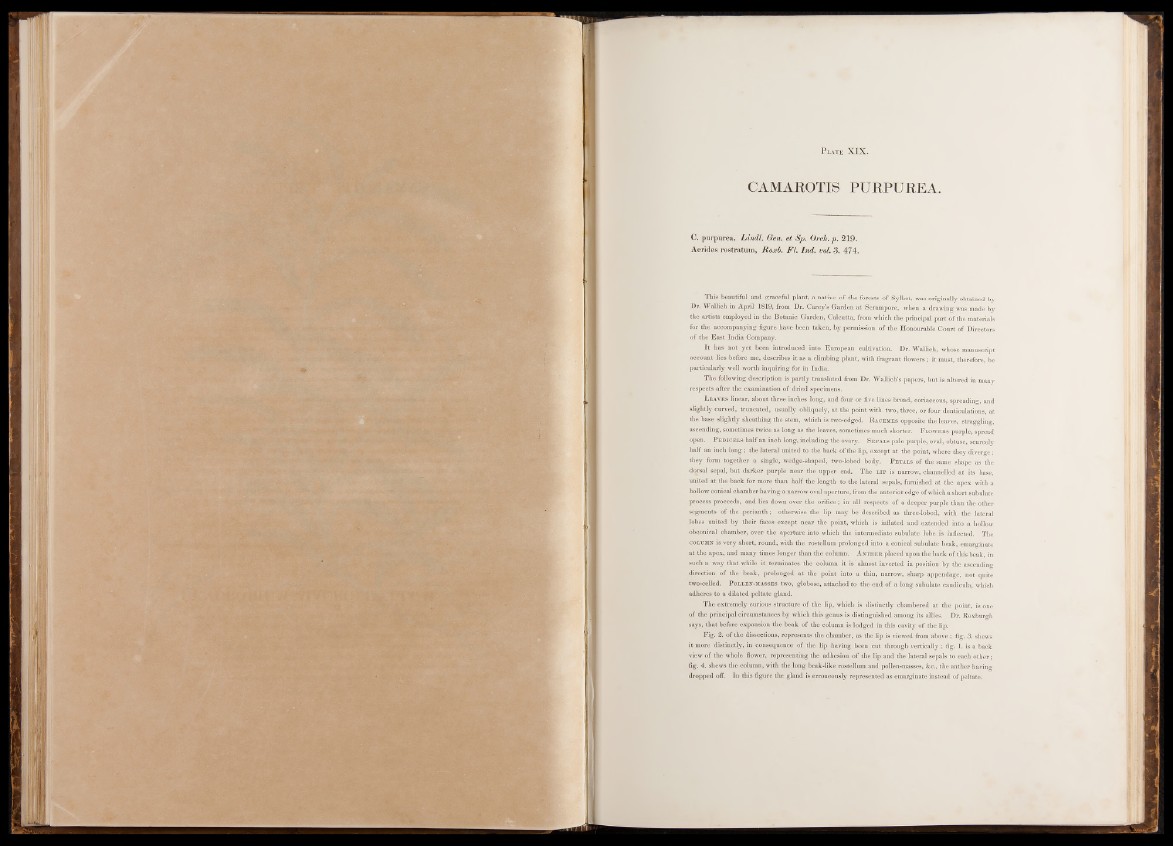
P late X I X .
CAMAROTIS PURPUREA.
C. purpurea, Lindl. Gen. et Sp. Orch. p. 219.
Aerides rostratum, Roxb. FI. Ind. vol. 3. 474.
This beautiful and graceful plant, a native of the forests of Sylhet, was originally obtained by
Dr. Wallich in April 1819, from Dr. Carey’s Garden at Serampore, when a drawing was made by
the artists employed in the Botanic Garden, Calcutta, from which the principal part of the materials
for the accompanying figure have been taken, by permission of the Honourable Court of Directors
of the East India Company.
It has not yet been introduced into European cultivation. Dr. Wallich, whose manuscript
account lies before me, describes it as a climbing plant, with fragrant flowers; it must, therefore, be
particularly well worth inquiring for in India.
The following description is partly translated from Dr. Wallich’s papers, but is altered in many
respects after the examination of dried specimens.
L e a v e s linear, about three inches long, and four or five lines broad, coriaceous, spreading, and
slightly curved, truncated, usually obliquely, at the point with two,, three, or four denticulations, at
the base slightly sheathing the stem, which is two-edged. R a c e m e s opposite the leaves, straggling,
ascending, sometimes twice as long as the leaves, sometimes much shorter. F l o w e r s purple, spread
open. P e d i c e l s half an inch long, including the ovary. S e p a l s pale purple, oval, obtuse, scarcely
half an inch long; the lateral united to the back of the lip, except at the point, where they diverge;
they form together a single, wedge-shaped, two-lobed body. P e t a l s of the same shape as the
dorsal sepal, but darker purple near the upper end. The l i p is narrow, channelled, at its base,
united at the back for more than half the length to the lateral sepals, furnished at the apex with a
hollow conical chamber having a narrow oval aperture, from the anterior edge of which a short subulate
process proceeds, and lies down over the orifice; in all respects of a deeper purple than the other
segments of the perianth; otherwise the lip may be described as three-lobed, with the lateral
lobes united by their faces-except near the point, which is inflated and extended into a hollow
obconical chamber, over the aperture into which the intermediate subulate lobe is inflected. The
c o l u m n is very short, round, with the rostellum prolonged into a conical subulate beak, emarginate
at the apex, and many times longer than the column. A n t h e r placed upon the back of this beak, in
such a way that while it terminates the column it is almost inverted in position by the ascending
direction of the beak, prolonged at the point into a thin, narrow, sharp appendage, not quite
two-celled. P o l l e n -m a s s e s two, globose, attached to the end of a long subulate caudicula, which
adheres to a dilated peltate gland.
The extremely curious structure of the lip, which is distinctly chambered at the point, is one
of the principal circumstances by which this genus is distinguished among its allies. Dr. Roxburgh
says, that before expansion the beak of the column is lodged in this cavity of the lip.
Fig. 2. of the dissections, represents the chamber, as the lip is viewed from above ; fig. 3. shews
it more distinctly, in consequence of the lip having been cut through vertically; fig. 1. is a back
view of the whole flower, representing the adhesion of the lip and the lateral sepals to each other;
fig. 4. shews the column, with the long beak-like rostellum and pollen-masses, &c., the anther having
dropped off. In this figure the gland is erroneously represented as emarginate instead of peltate.